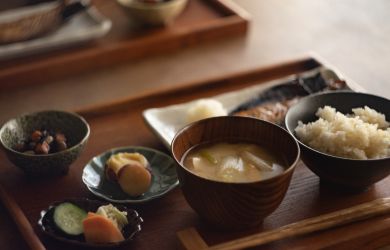
Originally published on metropolis.co.jp on October 2012


Freezing wind, boiling mud and blasted, naked rock. Oddly coloured lichenous growths, coiling steam and a sulphurous stench. Osorezan could be described as the Anti-Disneyland. Founded 1,200 years ago by the priest En’nin, this remote site in the far northern peninsula Shimokita-han was chosen due to its resemblance to the Buddhist vision of hell.
Bodai-ji temple sits in the shadow of Osore-san, which literally translates to “Fear Mountain.” An ongoing history of volcanic chicanery has left very little legitimate plant life in the basin. Instead, you’ll find black, twisted pumice, with steam boiling out of the ground and lashing across the temple grounds. Some areas look like the moon—others have a bizarre carpet of green, white, red and orange lichen.
Yet hell rests alongside heaven. This grim landscape sits within eight lushly forested mountains, resembling the eight petals of the lotus seating Amidha Butsu in the Western Paradise. Also within is the vivid blue Lake Usori, bordered by white sand—beautiful, but absolutely poisonous to all life due to sulphur and volcanic activity. Apparently, there are even 108 pools of boiling mud to correspond to the 108 worldly desires and their relevant hell… but we didn’t count.
The temple is dedicated to the Boddhisatva Jizo, a gentle, motherly guardian of children, travellers and damned souls, who refrains from Nirvana until all may enter, alleviating the pain of the lost.
Getting to Osorezan can be a headache, but that’s the price you pay for remoteness and isolation. Shukubo—accommodation in temple lodgings—will sting you for ¥12,000, but to best appreciate so unique a site, it’s worth the overnight stay. Quarters are not the harshly ascetic pilgrim’s cell you might be picturing, but a traditional, tastefully decorated and spacious 20-tatami room. Two vegetarian meals are provided, each preceded by prayer. Both were delicious and satisfying even for an athletic 20-something. The temple-stay also grants entry to what is probably the hottest, most sulphurously satisfying onsen you’ll ever visit.

Morning service begins at 6am in the main hall, followed by prayers in the Jizo hall. The more understanding you have of Japanese culture and language, the more the second round of services will affect you, though as Osorezan functions to pray for the souls of dead children, the routines and items of this hall are not difficult to comprehend. Some stories tell themselves and the tales of the Jizo hall are not happy ones.
The Itako-Taisai festival, from July 20-25, exhibits the last of a fading tradition as blind mediums communicate with the souls of the dead. Though this cultural highpoint is the first thing Japanese people will mention if you talk about visiting Osorezan, travelling there during what is the busiest time of the year would rob the experience of a unique isolation. Reading in your lodgings surrounded by calmness could be one of few chances to experience absolute silence in so densely populated a country.
If you are looking for a deeply moving personal experience, an ancient shadow cast by Japan-that-was, an escape from the neon plastic rush, or just a really weird picnicking spot, you can’t do much better.
You couldn’t call Osorezan uplifting or beautiful—but it’s fascinatingly apt as one of the holiest places in a strikingly atheistic country.
Inside Information
trip tips
Osorezan is closed from November until April. A shinkansen can get you to Aomori City (approx. ¥16,000), while overnight buses from Tokyo are a cheaper option. From Aomori station, a train runs to Shimokita station in 80 minutes—from there, buses run several times a day, taking a little under an hour to reach your destination.
Day trips to Osorezan are possible, but an overnight stay is recommended, in shukubo (temple-stay) lodgings alongside Bodai-ji temple. Book by calling 0175-22-3825, with an excellent English service.
Shimokita-han is right on the northern tip of Aomori—go much further and you’ll hit Hokkaido. Getting here takes time, effort and a lot of yen. Rather than blowing a king’s ransom on two shinkansen trips and a single rushed visit, consider building Osorezan into a longer trip on conventional trains and buses. You’ll find more than enough history and natural beauty in Yamagata, Akita and Aomori to make for a very memorable week (or more).
Aomori’s highlights include Hirosaki Castle, a small Edo-era castle in six walled compounds that now functions as a public park. With over a thousand sakura trees, it’s one of the finest blossom-viewing spots in the country.
You can also find Shirakami-Sanchi, a UNESCO-inscribed, untouched wilderness filled with ancient beech trees. It’s stunning in autumn. Aomori’s great natural beauty makes these spots an excellent pairing for a trip to this Lovecraftian landscape.
Dress warmly—it takes a long time for spring to find Osorezan.







